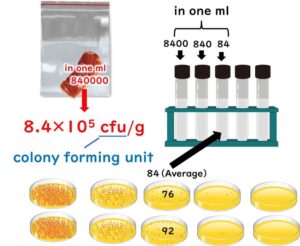Methods of testing for food micro-organisms (culture-based methods)
Explore the foundational culture-based methods for testing foodborne microorganisms. This category provides insights into traditional microbiological techniques, including standard plate counts and enzyme substrate media, essential for quality control and safety management in the food industry.
For beginners: the ISO method for E. coli testing on enzyme substrate media - explained in simple terms
Many companies are adopting the enzyme substrate medium method for their in-house testing of E. coli. But what about selecting the right medium or choosing the cultivation temperature? This article delves into the methods for testing E. coli based on the internationally recognized ISO standard, providing a detailed explanation.
Are We Missing Something? A Closer Look at Substrate Enzyme Media as Indicators in Microbial Testing
Once upon a time, a colleague of mine shared a rather intriguing story. They had proposed to their boss to switch from testing for fecal coliforms (think E. coli, the notorious block party crasher) to using a substrate enzyme medium that utilizes β-glucuronidase activity. However, their boss shot down the idea with the objection that this medium wouldn’t cover the infamous E. coli O157:H7. So, what’s the real scoop here? Are we overlooking some vital points in our understanding?
MRS Media: Tailored Nutrition for the Special Needs of Lactic Acid Bacteria
Explore the intricate relationship between the unique nutritional requirements of lactic acid bacteria (LAB) and their ideal growth environment provided by MRS (de Man, Rogosa, Sharpe) media. This article highlights how MRS media, formulated with rich sources of animal proteins, vitamins, and selective growth inhibitors, caters specifically to the demanding dietary needs of LAB. By offering insights into the selective properties and nutrient composition of MRS media, we reveal its critical role in fostering the proliferation of LAB, even in the challenging conditions of laboratory research and food safety testing. In this article, let’s get to grips with just how selective media like MRS agar really are for culturing lactic acid bacteria. We'll dive into the components that make up these media.
Deciphering Culture Medium Components: A Key to Effective Bacterial Testing
In this article, we emphasize the critical importance of understanding the components within culture mediums, especially in relation to how bacteria's varying sensitivities to hydrophobic functional groups are exploited in food safety testing. We explore the strategic application of this knowledge in using desoxycholate agar and BGLB broth for testing coliforms. Dive into how mastering the intricacies of medium components not only enhances the accuracy of bacterial detection but also reflects the clever subtleties of microbiological science. Ready to unravel the secrets behind each ingredient?
Navigating International Differences in Standard Plate Count Methods for Food
When interpreting standards for standard plate count (SPC) in food, it’s crucial to understand that the method of testing and measurement can vastly influence the outcome. In fact, the definition itself might change! This article highlights the methods used to test for standard plate count in food, with a special focus on contrasting approaches between the United States (AOAC method) and the European Union (ISO method), emphasizing the broader international discrepancies. Don your lab coats and prepare for a microscopic adventure into the world of food microbiology, where every detail can lead to a world of difference!
Unveiling the Truth About Standard Plate Counting: A Crucial Tool in Food Safety Management
In this detailed article, we revisit the significance of Standard Plate Counting (SPC), a fundamental microbiological test integral to food safety practices. Often referred to as Mesophilic Count or Aerobic Plate Count, SPC measures bacteria in food samples that grow aerobically at mesophilic temperatures. However, it's crucial to acknowledge its limitations, such as not detecting certain microbial groups like anaerobes or microaerophiles. This exploration discusses the intricacies of SPC, its application under various international standards, and its role not as a definitive indicator of food poisoning risk but as a vital tool in assessing the sanitary handling and temperature management of food products.
Standard Plate Count: A Beginner's Guide to Measuring Bacteria in Food Microbiology
In this article, we're taking you on a delightful dive into the world of food microbiology, specifically geared towards those just starting out. We won't be diving into the nitty-gritty of a full-blown experimental manual here. Instead, think of this as your friendly illustrated guide to understanding how bacteria are measured using the "standard plate count" method.
Visualising Microbial Counts: From Fresh Produce to Spoiled Food – A Walk Through the Microbial World
Imagine a vast field, stretching for kilometers, with just a few people scattered across it – each person representing a bacterium on the surface of fresh vegetables. This visualisation brings the invisible microbial world to life. But as food spoils, that serene scene quickly turns into the crush of a crowded train. In this article, we explore how microbial counts on fresh and spoiled food compare, helping us better understand the numbers that tell us when food is safe to eat.







